Local Food Service As A Rookie
Topic 20873 | Page 3
Bro. Got to say. Very informative. Very good. I like the thought of being home every day and still making 1100 buckaroos a week
OOS:
When a violation by either a driver or company is confirmed, an out-of-service order removes either the driver or the vehicle from the roadway until the violation is corrected.
Bro. Got to say. Very informative. Very good. I like the thought of being home every day and still making 1100 buckaroos a week
I would highly recommend getting some experience OTR before trying any local jobs. Most food/beverage drivers start fresh out of school, or have hands on learning while you have your permit instead of school. I feel that had I not had such an in depth training period (12 weeks after obtaining my CDL), or my experience working in the warehouse and being used to the work that I would be struggling quite a bit. For example, US FOODS only has you train for 1 week then you're on your own. I feel that my backing has improved greatly since i started but there are still some tight places i don't feel comfortable backing into. I couldn't even imagine trying to get a 48' or 53' into alot of these areas that are difficult enough with the 28' i pull. With the bigger trailers they aren't as sensitive when backing. There have been numerous times when i don't "chase" the trailer soon enough and the trailer "gets away" from me and I gotta pull up to get straight and try again. Another upside to the bigger trailers is they tend to load them with most of the product on one side of the trailer so that you can get to cooler and frozen through the back end. In my smaller trailer im required to climb the pull out steps in the freezer section usually until my last stop. Unfortunately some drivers dont report the steps needing to be replaced so it requires me to jackknife the truck just to get into frozen compartment using the catwalk of truck.
CDL:
Commercial Driver's License (CDL)
A CDL is required to drive any of the following vehicles:
- Any combination of vehicles with a gross combined weight rating (GCWR) of 26,001 or more pounds, providing the gross vehicle weight rating (GVWR) of the vehicle being towed is in excess of 10,000 pounds.
- Any single vehicle with a GVWR of 26,001 or more pounds, or any such vehicle towing another not in excess of 10,000 pounds.
- Any vehicle, regardless of size, designed to transport 16 or more persons, including the driver.
- Any vehicle required by federal regulations to be placarded while transporting hazardous materials.
OTR:
Over The Road
OTR driving normally means you'll be hauling freight to various customers throughout your company's hauling region. It often entails being gone from home for two to three weeks at a time.
OOS:
When a violation by either a driver or company is confirmed, an out-of-service order removes either the driver or the vehicle from the roadway until the violation is corrected.
Monday I was scheduled to run a route with another guy but instead got a call Sunday from my supervisor asking me to drive to one of our other domicile yards. I ran around Iowa City and then a bunch if small towns. In Iowa city I needed to deliver in the alleyway and it appeared I could pull straight through to get out as I seen a street sign on the other end of the alley. I pulled all the way in to double check that I could get out over there. I realized that there was a little creek with no road over it. I had 2 options: Unload my stop and then deal with backing out blind, or back out right away and back into the alley. I chose to back out then back into the alley right away. My reasoning was it was around 6am and little traffic so it'd be safer. I'm glad I did it that way because that road got Busy!! My day was only scheduled to be a 10 hour day so I was excited id be able to get back home and see my kids before they went to bed. Well, then I had one of those "that's trucking!" Moments and had been asked to go down to Ottumwa to help the driver I was originally scheduled to be with. His truck broke down on the side of the highway and had sat there from 730 to 230 waiting on Ryder (who we lease our trucks from) to bring him a replacement. I had to drive an hour to get to where he was. Sure enough as soon as I pulled up to where he was and got ready to move 2 stops onto my truck the tow truck showed up with his replacement. I decided that id follow him to his next stop because itd be alot safer to transfer cases to my trailer in a parking lot rather than the side of the highway. Both of us needed to use our 16 hour extension, but we both made it back to our respective yards. I'm not going to get into the specifics of the 16 hour rule, because I don't want to cause confusion. As it ONLY. Applies to drivers returning to same place they started their day, and NOT OTR DRIVERS. Also, not every company that is eligible wants their drivers to use it, and your company will educate you on regulations surrounding it. When the day was all said and done, I worked 15 hours (not including my commute), drove 265 miles, 600 cases, 14k. To top it all off, not knowing where I was as I had never been out that way I unfortunately had to rely on GPS (Big no no by the way). I was lucky that my only misfortune with the GPS was it had me go down a couple dirt roads.
Tuesday I had returned to the other domicile to run that route again. I was originally dispatched for 4am but because I didn't finish Monday until nearly 7pm I had to have dispatch bump me back to a 5am start to get my 10 hour break in. Day was alot less eventful, but dang there were a ton of tight turns and very narrow alleyways. My day was spent in alot of real small towns that were built in the late 1800's. The alleyways I needed to deliver in had only q couple inches of space on each side of my trailer. Thankfully I was able to pull straight in. Had I needed to back in from the street I wouldn't have even attempted it. I ended up doing a 13 hour day, 600 cases, 14k 189 miles. I don't mind working in another yard because they pay me 87 CPM from my house to where I'm going but it makes for a long day not knowing the area. Also, add to that the commute on top of the scheduled work day. I'll end up making an extra $270 or so just from traveling. Wednesday (today) I'm on my usual route and have another guy with me. I was scheduled to start at 530 but our truck is there at 3 so we got an earlier start. I get to sit in the passenger seat today because I wouldn't have been able to drive until 430 or so, so for us to start as early as we usually do he said he would drive today.. It'll end up being about a 12 hour day. After today ill be just about on overtime, and I still have 2 more days to work which are usually 12 hour days. Alot of hours but at least the paycheck should be nice.
OTR:
Over The Road
OTR driving normally means you'll be hauling freight to various customers throughout your company's hauling region. It often entails being gone from home for two to three weeks at a time.
CPM:
Cents Per Mile
Drivers are often paid by the mile and it's given in cents per mile, or cpm.
HOS:
Hours Of Service
HOS refers to the logbook hours of service regulations.OWI:
Operating While Intoxicated
This last week was very busy and very tiring. Because I worked 5 days, rather than only 4 I ended up putting in a little over 62 hours. I chose to start my career as a local driver to be able to see my kids daily however having to fill in at another yard throws that out of whack. Unfortunately I didn't get to see them Monday or Tuesday due to having to drive an hour back hone after finishing my route. When all is said and done I should gross $1,635, plus the $252 for mileage driving to /from the yard bringing total to nearly $1,900 for the week. The money is good, but you earn it with the amount of physical labor, and hustle required. As I've said before, you can make great money doing food service however you can make very similar money as a OTR , or dedicated driver if you prove yourself to be a reliable, safe, "top tier" driver.. This job works for me, but many others think I'm crazy for doing it.
OTR:
Over The Road
OTR driving normally means you'll be hauling freight to various customers throughout your company's hauling region. It often entails being gone from home for two to three weeks at a time.
HOS:
Hours Of Service
HOS refers to the logbook hours of service regulations.Monday (yesterday) was quite an experience. I got sent from Des Moines out to Omaha Nebraska. This route used to be run out of Des Moines but due to being short handed here they had to run it out of Rock Island Illinois with the driver having to do a layover in a hotel. This obviously is saving the company money on not needing to spend extra money, as we can make it back same day. Yesterday it was my turn to join the fun.
It was pretty foggy from 10 miles outside Des Moines all the way out to Council Bluffs Iowa. It was a pain in the rear doing 65 then hitting a worse patch of fog and only doing 45 for a couple miles. It took me about 3 hours to make the trip. I've only every driven through Omaha once in a personal vehicle so I was nervous about going out there. To make matters worse they're doing a bit of construction on I-80. I unfortunately had to rely on GPS to find my stops which I luckily didn't get into any trouble with. Overall it was a pretty stressful day. I have no doubt gotten spoiled with the (lack of) traffic in Des Moines, compared to other big cities. I had 6 stops in Omaha, and my final stop was in Lincoln Nebraska. Overall, it was 7 stops, 562 cases, 13k hand unloaded, 413 miles nearly a 15 hour day. I once again had to use my HOS Extension. I should be able to get back in less time as I get more familiar with where the stops are out there so I'm not wasting time plugging at GPS or figuring out best way to position the truck. Side note: It doesn't make financially for the company to send us out that far. The only reason they do it is when they bid on contracts with chain restaurants, nursing homes or hospitals they're required to service all of those accounts in that companies region. In our case, we have trucks that leave rock island and go to Minneapolis. as well as Sioux Falls, as well as Omaha because its in the contract. They try to pick up additional business in those areas to help minimize the loss they take on that particular run. Obviously they're making enough off the local stops that are part of that chain otherwise they wouldn't have bid on it.
We'll see how it goes once the snow starts flying....if they keep me on that run.
HOS:
Hours Of Service
HOS refers to the logbook hours of service regulations.The moderators here are frequently telling people that local gigs require alot of difficult backing situations, and maneuvering in close quarters. I just wanted to share a pic real quick of one of my stops I had today. Here is the pic of the "hole" I had to get the trailer in.
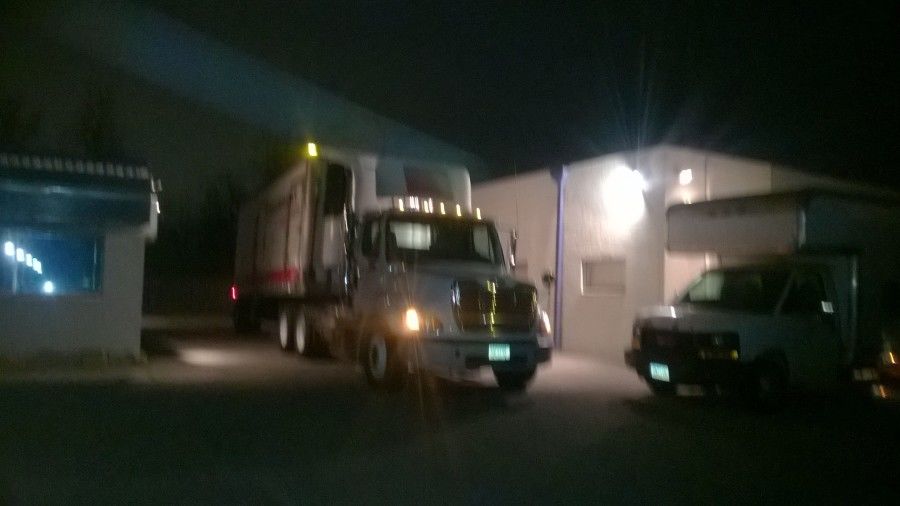
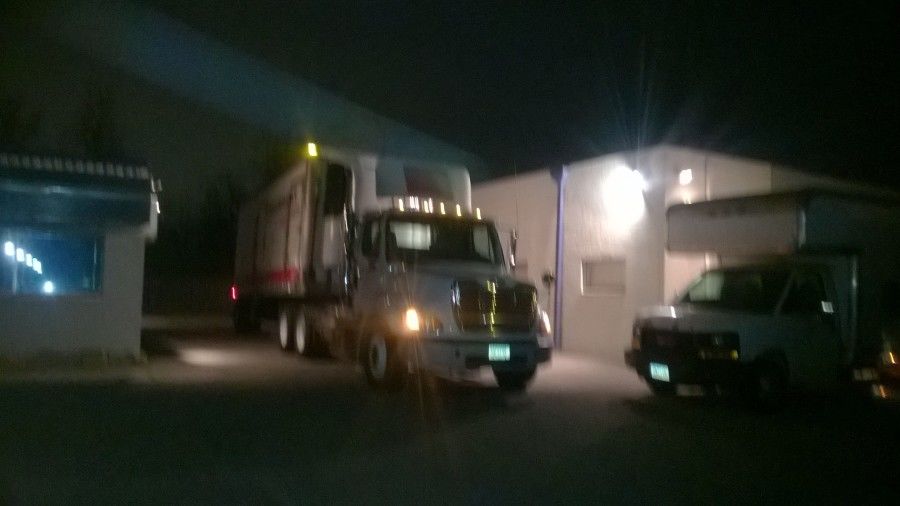 .
.
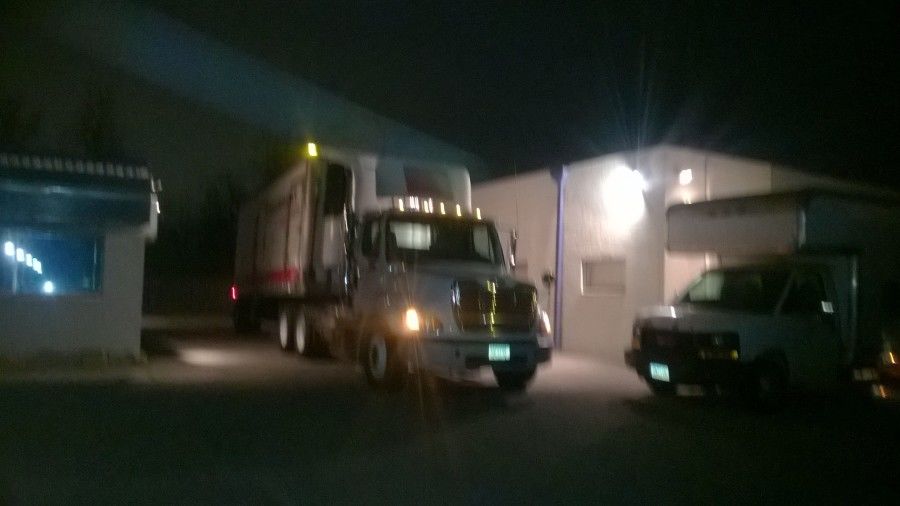 this definitely isn't the most difficult place we have to get into but it still trips me up occasionally despite me going there nearly every Thursday. I've now been driving just over 4 months. What you can't see in this picture is you back in from the street. The street is only a 2 lane road that has a fire hydrant and telephone poles right next to start of driveway/parking lot. It also has a fence on other side of street, giving me very little space. Add into this scenario traffic that doesn't want to wait on you to get it in. As soon as they have ANY room they'll crowd you or whip around you. Mix all of that with needing to get in between the buildings its definitely a challenge (particulary when new). Its very tight to get it angled in there just right and even though my trailer is only 28 feet it is alot more sensitive. It "gets away" alot quicker than a 53 footer would, requiring you to pull up/out and try again. Its easy to get frustrated when your faced with this situation but when you allow frustration or nerves to get to you that's when mistakes happen. Tomorrow (time permitting) ill be taking some more pics to show more about what I do.
this definitely isn't the most difficult place we have to get into but it still trips me up occasionally despite me going there nearly every Thursday. I've now been driving just over 4 months. What you can't see in this picture is you back in from the street. The street is only a 2 lane road that has a fire hydrant and telephone poles right next to start of driveway/parking lot. It also has a fence on other side of street, giving me very little space. Add into this scenario traffic that doesn't want to wait on you to get it in. As soon as they have ANY room they'll crowd you or whip around you. Mix all of that with needing to get in between the buildings its definitely a challenge (particulary when new). Its very tight to get it angled in there just right and even though my trailer is only 28 feet it is alot more sensitive. It "gets away" alot quicker than a 53 footer would, requiring you to pull up/out and try again. Its easy to get frustrated when your faced with this situation but when you allow frustration or nerves to get to you that's when mistakes happen. Tomorrow (time permitting) ill be taking some more pics to show more about what I do.
Ooops. Didn't mean to share same pic 3 times...was taking forever to load.
Today (Friday) I had to deal with icy roads. We had gotten a bit of freezing rain overnight with a dusting of snow that was causing alot of trucks to spin out, and several accidents. I thankfully was only loaded with 506 cases, 12k pounds, 10 stops. The worst thing I dealt with was needing to throw some salt down at the first few stops prior to unloading to help ensure I wouldn't hit an icy patch as I came down the ramp.
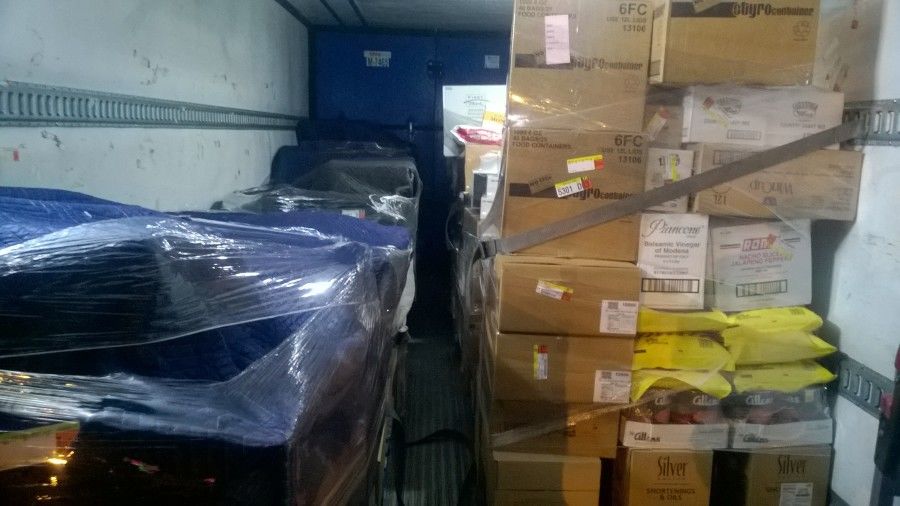 This is a picture of what the trailer looked like when I opened the doors up this morning. 4 cooler pallets, 4 dry, and 1 freezer pallet (behind the bulkhead). The first stop I had was our largest non-chain account. They ended up taking 200 cases, 6k pounds. You may see some labels on the right hand pallet with a number on it. That number (1) is the stop number so I can spot what I need easier. Then I have to scan it after I place it on the dolly.
This is a picture of what the trailer looked like when I opened the doors up this morning. 4 cooler pallets, 4 dry, and 1 freezer pallet (behind the bulkhead). The first stop I had was our largest non-chain account. They ended up taking 200 cases, 6k pounds. You may see some labels on the right hand pallet with a number on it. That number (1) is the stop number so I can spot what I need easier. Then I have to scan it after I place it on the dolly.
See next post for continuation as I can only post 1 pic in a post.....
Bulkhead:
A strong wall-like structure placed at the front of a flatbed trailer (or on the rear of the tractor) used to protect the driver against shifting cargo during a front-end collision. May also refer to any separator within a dry or liquid trailer (also called a baffle for liquid trailers) used to partition the load.
New Reply:
New! Check out our help videos for a better understanding of our forum features

















Preview:
This topic has the following tags:
Advice For New Truck Drivers First Truck Driving Job Food Service Local CDL Drivers Regional Jobs






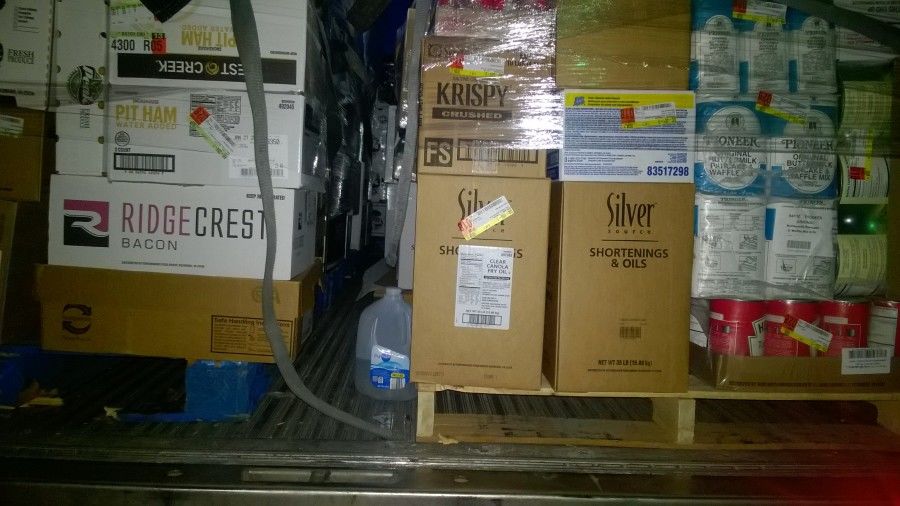

 TT On Facebook
TT On Facebook
What a day! Today I was alone, started at 4am and had my usual route switched up. Thankfully I've been to all these places before but still took me by surprise. I had 719 cases, 17k in the box, drove 105 miles, worked 12 hours. My trailer was loaded clear to the tail, (see picture below) had maaaaybe half a foot of space to stand. In order to work safely I had pull out my ramp that I wheel down half way to use as a platform so I could downstack pallets. It sucks having no space not only for safety reasons, but it causes me to touch cases multiple times. The goal is to be the most efficient, sorting the pallet as you search for the products you need. One thing to keep in mind is the warehouse doesn't build the pallet based on what stop it is, on the label they slap onto the case it tells them what pallet (pull 2 pallets at once) and if it goes in front or back. Often times your stuck digging for the product you need, especially in the "cooler" pallets. For food safety, chicken, meat pork MUST be on the bottom.